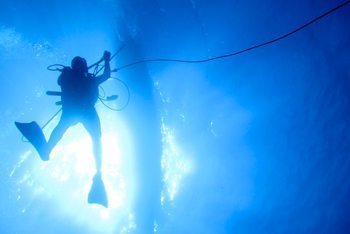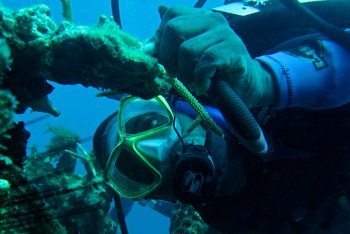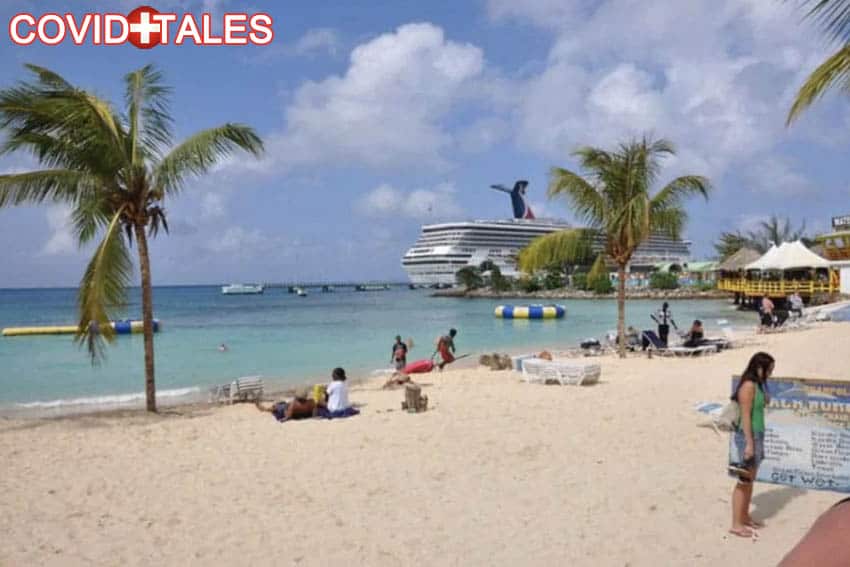
Cleaning the Reef in Oracabessa, Jamaica
By David Peters

I wondered what I was doing. Watching intently and photographing as three men surveyed their underwater garden, possessively cleaning coral and rocks with toothbrushes.
They do this twice a week in an attempt to rebuild Jamaica’s damaged reef. I was in Oracabassa, a small coastal fishing town in the North-East of Jamaica. A unique and inspirational example of environmental re-generation within this bustling Caribbean island.
Oracabessa, Spanish for ‘Golden Head’ after the amazing sunsets in the bay was made famous as the holiday home of Ian Fleming.
Ursula Adress strutted her stuff in her white bikini just down the coast. Since then large parts of the town have been bought up and developed by Island Records owner Chris Blackwell – the producer of Bob Marley among others.

One of his most impressive projects was to turn Fleming’s beach house and the surrounding beachfront property into the exclusive ‘Golden-Eye Resort’.
There are many other, far more affordable guest houses, along the nearby coast and inland, starting from $10 USD per night. Further down the coast in Boscobel is a huge all-inclusive Beaches resort.
Fishermen’s Bay
I was lucky enough to pull into Fisherman’s bay on a sailboat where we anchored for four days. Initially unsure whether outsiders were welcome in this small cove we were met by ‘Di Enforsa’ the patrol boat and advised where to anchor.

When we had paddled to the land word had spread of the new visitors and we were given a traditional Jamaican welcome of ‘Wa-gwaan, where you from…’ and a unique handshake (which we are well-practiced at after two months, and clearly boosts our street cred!).
The beach is small – just two hundred feet long, so littered with fishing boats there is barely an inch of space to leave our kayak. There is outward pride in one’s boat, garish paint jobs and uniquely Jamaican names. ‘Jah Bless’ sports the red, green and gold Rasta colors.
‘Legend’, ‘Oh’ Henry’ and ‘Marlin King’ all boast bright block colors and pictures of the fish they hope and dream of catching around the reef edge. The smaller boats, who cannot afford an outboard engine are forced to use paddle power and have less time for a paint job.
Further up the beach is a container come office which is home to the ‘Oracabessa Bay Fish Sanctuary’. One of nineteen fish sanctuaries around the island this organization has received substantial funding to set up a no fish zone around the Oracabessa bays to help re-generate fish populations and the reef.

Fishing as Sustenance
This is one of the most notable issues and problems facing Jamaica. The island is surrounded by a small belt of reef and then a huge drop-off to several thousand feet. Coastal towns focus on fishing as a means of sustenance because people often have few other employment options.
This has meant line, net, and spearfisherman catching more and more small, juvenile fish in ever-deeper water. Fish stocks are being depleted dramatically. At the same time, a combination of past tropical storms, a disease that affected sea urchin numbers, and other human-related issues such as the discharge of wastewater and bleaches into coastal waters have meant the coral reef has sustained irreversible damage.
Just a few hundred miles away in the Bahamas and Cuba there are abundant reefs. Jamaica has little live coral; most of the coastal region is a blanket of dank, green algae.

Enter the Fish Sanctuary, managed by enthusiastic marine biologist Inilek Wilmot with the support of an American Peace Corps group they have established several schemes within the framework of a cooperative with local fishermen to protect their most valuable resource.
On my first day in the bay, I joined Gore, Ratty, and Scratchy – all of whom are or have been, spearfishermen in their time, they are now spearheading the reef regeneration project.
On the edge of Fisherman’s Bay, they have washing lines full of small pieces of staghorn coral – this is the coral nursery where sections are left to grow and develop.
When they reach a big and healthy enough size they are transferred to a designated patch of reef, the coral garden in front of the ‘Golden-Eye Resort’ and planted. At first sight, you would not think you are in Jamaica – this project has been so successful in its two years of operation.
Coral Abundant
Coral is abundant; the divers have kept algae at bay, pruning their garden. Their weekly dives now focus on cleaning and maintaining the coral and attempting to eradicate the coral predators – small snails and larger fire worms which feed on the coral and kill or bleach it.
The next day Gore and Ratty were out diving again laying a mooring ball. The markers signal the edge of the sanctuary to help wardens and fishermen define the boundary more clearly. The way the cooperative functions is key to its success. 12 wardens work on rotation 1 month on three months off.
Funding has meant the wardens receive a basic salary. When they are not working with the sanctuary

many wardens are themselves fishermen or are involved in construction around the town. All of the wardens and divers are extremely passionate about re-developing their fish stocks and have all noticed substantial improvements in fish size and numbers on the outer edge of the sanctuary since it was started.
One warden estimated a 97% compliance rate. This is far higher than in other areas where NGOs dictate to fishermen what they can and cannot do – mooring lines are cut and sanctuary boundaries are clearly flaunted.
Turtle Conservationist
On our second evening in Oracabessa Bay, we were put into contact with Mel Tennant. A retired, British, school head-teacher turned turtle conservationist. 10 years ago, after relocating to Oracabessa, he noticed strange tracks in the sand in front of his home. Late at night, suspicious people walked the beach, it emerged they were fueling the local demand for turtle eggs – cracked into an un-appetizing milkshake, legend has it the eggs have the same effect as Viagra.
Mel took it upon himself to limit this practice, which is highly illegal. And he began monitoring the turtle laying sights and has developed a technique to predict when eggs will hatch. His project has become somewhat of a tourist attraction in the town, appealing to the human appetite to see one of nature’s wonders at work.

We looked on in amazement as 135 baby Hawksbill turtles were helped out of a small hole in the sand, placed in a bucket, and then set free down the beach. Their internal compass guided them into the surf and towards their new ocean home.
Through a collaboration with the fish sanctuary, Mel has been able to extend his project to 4 beaches, and in the coming months, he hopes to attract young and enthusiastic marine biology volunteers to help sustain and further develop his re-habilitation and tagging program and further increase turtle numbers around Jamaica.
My last day and last dive in Oracabessa was with two marine biology students from the University of the West Indies. They are undertaking a fish survey inside and outside the sanctuary boundaries.
They were unwilling to admit how effective the sanctuary has been until they have analyzed their statistics, but to the untrained eye, and after diving and snorkeling on a daily basis during my sailing trip around the island, the reef around the new coral garden is the most abundant I have seen in Jamaica.
Lots of Fish
Big snappers and jacks were darting around the coral, and juvenile parrotfish (one of the most popular fish in the local diet) were commonplace.

When I told the two wardens on the boat after my dive that it was the best dive and the most fish I had seen in Jamaica there was a real sense of pride. They said, “wow, thank you, thank you, so we are doing a good job”. “Yes,” I said, “a very good job.”
It is clear that fishing is an important trade for many people in coastal towns throughout Jamaica. However, it is also clear that unchecked current fishing practices are not sustainable.
That is why organizations like the Oracabessa Bay Fish Sanctuary should act as an example. A responsible and reciprocal relationship between environmentalists and local fishermen, trying to make their living, has allowed reef areas to re-develop and fish numbers to improve.
Oracabessa is accessible by international airports in Kingston and Montego Bay. It is about 2 hours of travel time from both. Mel Tennant’s turtle volunteers can stay in his guest house.
Other volunteers have a range of guest houses available along the coastline – all within 10 minutes of the fisherman’s beach, and Oracabessa town center. It is a very small town with two supermarkets, a small farmer’s market, and a couple of meat shops. Despite being small there are plenty of places to stock up on healthy and fresh local produce.
Getting There
Project Moana is a social enterprise currently on photography, videography, and fact-finding expedition around Jamaica. We are creating links with environmental groups and marine parks around the country and are in the process of setting up volunteer programs.
Mel Tennant of the Turtle Rehabilitation Program is keen to attract volunteer help, and the Fish Sanctuary requires help to increase its funding options and increase its internet presence through a website and social media marketing. Please visit www.projectmoana.com for more information.

David Peters was born in England. He lived aboard a 50-foot sailboat for 6 months. He is currently teaching Scuba Diving in the British Virgin Islands.
- Mongolia, the Land of Eternal Blue Sky - April 20, 2024
- These 9 U.S. National Parks Require Reservations in 2024 - April 17, 2024
- Take a Hike in Olympic National Park - April 17, 2024


